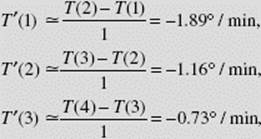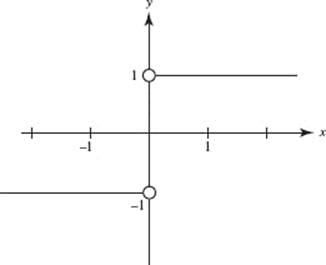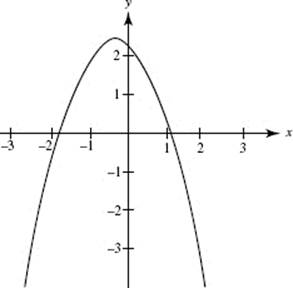Calculus AB and Calculus BC
CHAPTER 3 Differentiation
E. ESTIMATING A DERIVATIVE
E1. Numerically.
EXAMPLE 22
The table shown gives the temperatures of a polar bear on a very cold arctic day (t = minutes; T = degrees Fahrenheit):
|
t |
0 |
1 |
2 |
3 |
4 |
5 |
6 |
7 |
8 |
|
T |
98 |
94.95 |
93.06 |
91.90 |
91.17 |
90.73 |
90.45 |
90.28 |
90.17 |
Our task is to estimate the derivative of T numerically at various times. A possible graph of T(t) is sketched in Figure N3–3, but we shall use only the data from the table.

FIGURE N3–3
Using the difference quotient ![]() with h equal to 1, we see that
with h equal to 1, we see that
![]()
Also,

and so on.
The following table shows the approximate values of T ′(t) obtained from the difference quotients above:
|
t |
0 |
1 |
2 |
3 |
4 |
5 |
6 |
7 |
|
T ′(t) |
−3.05 |
−1.89 |
−1.16 |
−0.73 |
−0.47 |
−0.28 |
−0.17 |
−0.11 |
Note that the entries for T ′(t) also represent the approximate slopes of the T curve at times 0.5, 1.5, 2.5, and so on.
From a Symmetric Difference Quotient
In Example 22 we approximated a derivative numerically from a table of values. We can also estimate f ′(a) numerically using the symmetric difference quotient, which is defined as follows:
![]()
Note that the symmetric difference quotient is equal to
![]()
We see that it is just the average of two difference quotients. Many calculators use the symmetric difference quotient in finding derivatives.
EXAMPLE 23
For the function f (x) = x4, approximate f ′(1) using the symmetric difference quotient with h = 0.01.
SOLUTION: ![]()
The exact value of f ′(1), of course, is 4.
The use of the symmetric difference quotient is particularly convenient when, as is often the case, obtaining a derivative precisely (with formulas) is cumbersome and an approximation is all that is needed for practical purposes.
A word of caution is in order. Sometimes a wrong result is obtained using the symmetric difference quotient. We noted that f (x) = |x| does not have a derivative at x = 0, since f ′(x) = −1 for all x < 0 but f ′(x) = 1 for all x > 0. Our calculator (which uses the symmetric difference quotient) tells us (incorrectly!) that f ′(0) = 0. Note that, if f (x) = |x|, the symmetric difference quotient gives 0 for f ′(0) for every h ≠ 0. If, for example, h = 0.01, then we get
![]()
which, as previously noted, is incorrect. The graph of the derivative of f (x) = |x|, which we see in Figure N3–4, shows that f ′(0) does not exist.

FIGURE N3–4
E2. Graphically.
If we have the graph of a function f (x), we can use it to graph f ′(x). We accomplish this by estimating the slope of the graph of f (x) at enough points to assure a smooth curve for f ′(x). In Figure N3–5 we see the graph of y = f (x). Below it is a table of the approximate slopes estimated from the graph.

FIGURE N3–5
|
x |
−3 |
−2.5 |
−2 |
−1.5 |
−1 |
0 |
0.5 |
1 |
1.5 |
2 |
2.5 |
|
f ′(x) |
−6 |
−3 |
−0.5 |
1 |
2 |
2 |
1.5 |
0.5 |
−2 |
−4 |
−7 |
Figure N3–6 was obtained by plotting the points from the table of slopes above and drawing a smooth curve through these points. The result is the graph of y = f ′(x).

FIGURE N3–6
From the graphs above we can make the following observations:
(1) At the points where the slope of f (in Figure N3–5) equals 0, the graph of f ′(Figure N3–6) has x-intercepts: approximately x = −1.8 and x = 1.1. We’ve drawn horizontal broken lines at these points on the curve in Figure N3–5.
(2) On intervals where f ![]() the derivative is
the derivative is ![]() We see here that f decreases for x < −1.8 (approximately) and for x > 1.1 (approximately), and that f increases for −1.8 < x < 1.1 (approximately). In Chapter 4 we discuss other behaviors of f that are reflected in the graph of f ′.
We see here that f decreases for x < −1.8 (approximately) and for x > 1.1 (approximately), and that f increases for −1.8 < x < 1.1 (approximately). In Chapter 4 we discuss other behaviors of f that are reflected in the graph of f ′.
BC ONLY